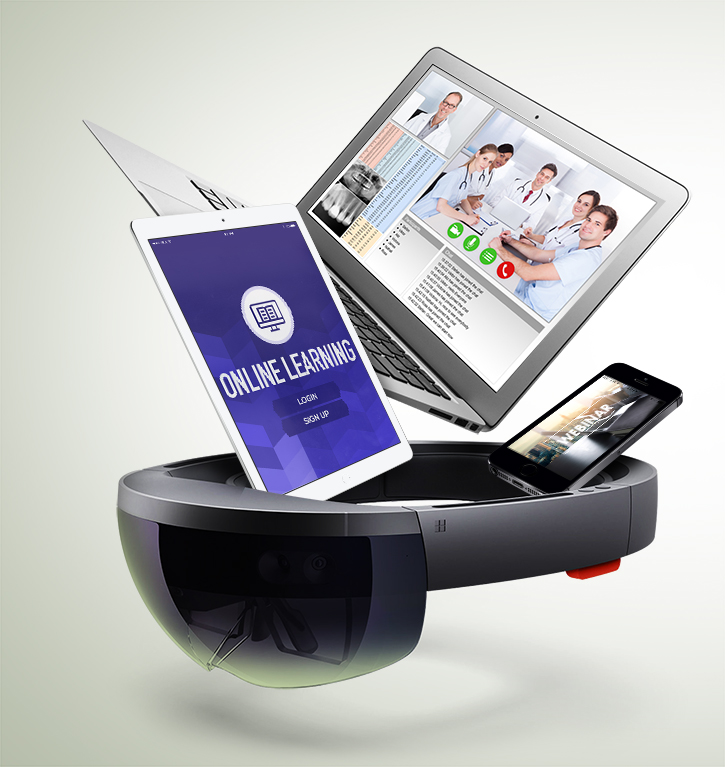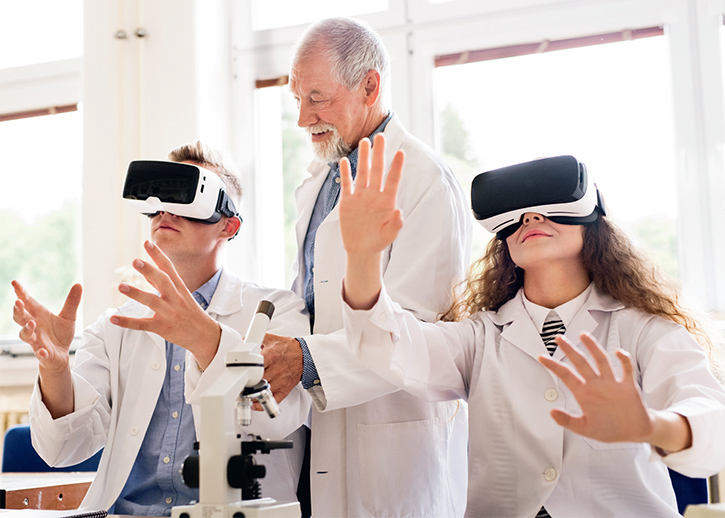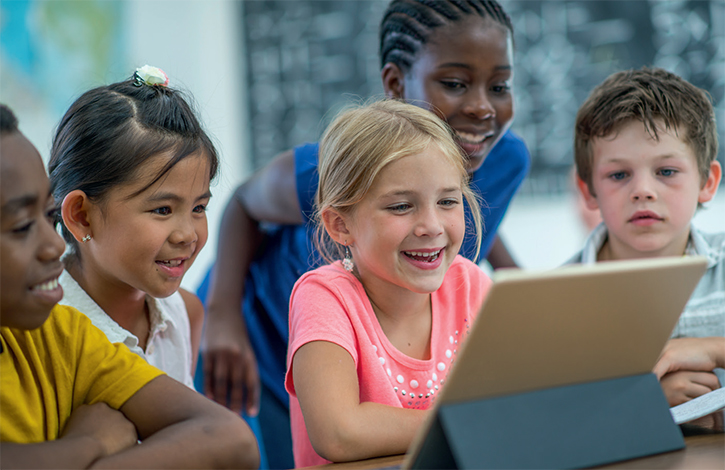School of Screens

Students have come to expect innovative technology in their learning spaces, but to be effective, tools like video streaming must offer engaging material that adds an extra dimension to lessons.
Schools and universities have been working with video conferencing for over two decades now to enrich learning and broaden students’ world views. Today, sexy new tech like virtual reality (VR), augmented reality (AR) and both mashed together, mixed reality (MR), are emerging on the streaming video horizon, expanding the opportunities for experience.
Video streaming now is all about being part of something, and taking part in a genuine experience, according to Dr. John Collick, senior education consultant at Promethean. His company develops a variety of technology solutions for the 21st century classroom.
“Why did more than two million people watch Elon Musk’s Falcon Heavy rocket launch?” Collick asks. “Quite simply, to belong to a significant moment in space exploration. A factor driving video streaming is belonging to a community of like-minded people. In the education context this sense of belonging to the moment and to the community can be very effective, and so video streaming is naturally becoming a part of the learning process.”
Good or Bad for Education?
On whether education through streaming video is really beneficial for students and educators, Jeff Rubenstein, VP product for learning and collaboration at Kaltura, states: “Streaming video has been revolutionary for teaching and learning. It removes the restrictions of the physical classroom. Students can get lessons anywhere, anytime and can interact with their instructor and with fellow students anywhere in the world, using combinations of asynchronous and synchronous video technologies.
“Video also makes learning more accessible: students can watch and re-watch the lessons as often as they like, and on any device,” Rubenstein adds. “And video can be captioned and translated into other languages. This is good not only for people with disabilities, but for all students.”
Chris Michaels, streaming industry evangelist at Wowza Media Systems, agrees: “We’ve seen programmes have tremendous success with distance learning, creating intimate experiences for the students that otherwise wouldn’t have a live interaction with an instructor. This closeness allows the student to be more receptive to the lessons. Additionally, when the videos implement a live to video on demand strategy, allowing for lessons to be saved for later viewing, students can return to previous lessons, or even rewind to better understand a particular portion of the lecture.”
While Collick comments: “For both students and teachers, streaming video gives the sense of participation and sense of authentic experience, a crucially important part of creating engaging learning experiences.
“Streaming video presents many diverse education opportunities for students,” he continues. “Firstly, by gaining access to experts worldwide, students can interview people and watch live demonstrations of experiments. Secondly, it also enables communication in real time, whether that’s students class-to-class or students demonstrating their work to parents.”
Collick says that for teachers, video streaming allows reach to a much bigger audience and to share experiences with their colleagues, regardless of geographical boundaries. “Unlike pre-recorded video content, with video streaming, educators can receive immediate feedback from the audience, which facilitates greater interaction and more meaningful learning opportunities.”

Expanding Horizons New technology such as AR, VR and MR will add a new experience to streaming video.
“The hazard can come when programmes rely on platforms like YouTube to host their lessons natively.”
Huge Demand from Students
In a recent survey conducted by Panopto of 500 students studying at 135 different UK universities, the company found that 78% of students were already using online video platforms to teach themselves additional skills or learn new things, and 65% were being given access to on-demand video lectures by their university.
As well as lecture recording, Panopto observed huge growth in the number of institutions using video to do things like flip the classroom, record video feedback to student assignments and live stream guest lectures or university events. Students are typically very enthusiastic about these kinds of learning resources, the company said, and they feel video resources offer them greater flexibility, the chance to absorb more complex material at their own pace and the opportunity to catch up if classes are missed due to illness or other commitments.
Peter Ingle, general manager at Panopto EMEA, comments: “From our work with hundreds of universities, colleges and schools globally, we know that introducing video as a complement to face-to-face learning can have a big impact on student engagement. Students who experience video learning are overwhelmingly positive about it and many academics tell us it has transformed their teaching practice, for the better. With the majority of UK universities now using video in a wide range of ways, students are increasingly coming to see blended learning – the combination of face-to-face and digital learning tools – as the norm.”
Patricia Finlayson, senior product and solutions marketing manager of videoconferencing tech company Polycom, states: “The current generation of younger students are digital natives, and mature students are likely to be comfortable with mobile and video technology; both have high expectations for their education establishments to keep up to date with the latest innovative technology.”
As to risks associated with this technology, Collick says: “Streaming video is only effective when the content is meaningful and engaging for students. If students are not given choice in what they watch, or what they watch is uninspiring or of questionable quality, it won’t bring any educational benefit.”
“The hazard can come when programmes rely on platforms like YouTube to host their lessons natively,” Wowza’s Michaels adds. “While YouTube is a great platform for free distribution and storage, viewers can easily be distracted by other videos or channels in suggested posts, and perhaps content that may contradict current lessons, or provide opposing analysis to specific points of instruction.”

Greater Understanding Video on demand allows students to enhance their learning by revisiting lessons
“Streaming video is only effective when the content is meaningful and engaging for students.”
Into the classroom
On innovative uses of streaming video in education today, Michaels states: “Live video gives schools the ability to extend the feel of community beyond the campus walls and has enormous potential for both student life and recruiting, maintaining and building relationships with alumni, donors and parents. St Andrews School, a private boarding academy in Delaware, regularly streams lectures from visiting professors, student events, fine arts performances and parents’ weekends. This allows parents, extended families and communities to be connected, even while apart.”
Michaels adds that University College London (UCL), the third-largest university in the UK with the largest postgraduate enrolment in the country, streams live and on-demand video, and uses 360° video to create exclusive events that help extend their reach and maximise student and community engagement. This can be student orientation and virtual tours of research organisations and departments, plus training and internal communication so students and viewers can feel like they are physically there.
UCL also offers a regular Lunch Hour Lectures programme twice a week, featuring faculty philosophers, authors, researchers, doctors, civil rights activists and celebrities. Established in 1942, the lecture series allows anyone the opportunity to sample the exceptional research work being undertaken at the university. The lectures are both streamed to an adjoining auditorium, as well as online and to YouTube for international audiences. Since starting to stream the lectures, the series has had millions of views from around the world.
In another example of the innovative use of video plus new tech, Pearson TQ, which delivers engineering and plant operator training at the Royal School of Military Engineering, used interactive 360° headsets, the HoloLens from Microsoft, to give learners the chance to explore maintenance bays in VR. This allowed students to quickly get used to working in the bays, learning about the position of tools and different features, without leaving the classroom.
Promethean’s Collick notes that for teachers, streaming video is not only a tool to share best practices, but also a way of reaching a very specific audience. “I have a friend who is the head of a language school in Russia and while on a trans-Siberian tour by train he did live stream video interviews with managers of language schools in cities along the route. They all shared their secrets of school management which resulted in a precise reach for his targeted audience.”

Streaming
There are three key trends in this sector that Panopto believes will only grow with time.
Firstly, continued demand for anytime, anywhere learning from students. This means providers have to ensure that any recordings made are optimised for playback on any device, allowing students to use their mobile devices to access content whenever, wherever.
Secondly, capture of video at scale. Panopto said it already sees UK universities that are capturing the vast majority of their lectures, as well as a range of other video content.
Finally, the increasing uptake of multi-camera video for learning. This will be particularly key for instructors in practical subjects who need to show key processes.
Collick states that one trend in the development of this technology is bringing the most realistic and authentic experience to the student audience, the ultimate example being the streaming of moving holographic images of speakers. Promethean sister company ArHT Media demonstrated this at education show Bett by showcasing how its HumaGram technology could be applied in education settings.
“With video streaming, everyone is a creator and so the development of easy-to-use tools is essential,” continues Collick. “We can expect that technology will develop to create fully immersive live streaming experiences while there will also be the development of small wearable devices which can easily make any teacher or student a broadcaster. Platforms for streaming with an easy search of recorded video sessions and aggregated content will be very important for life-long learners and teachers. These platforms should give a teacher the opportunity to search for the future live broadcasts they need for specific times and learning purposes.”
Polycom’s Finlayson says: “The big push from us has been for audio and video solutions that give the most real and life-like experience. In the future, I expect technology will continue to evolve to adapt to the changing and growing demands in the education space. Giving students access to virtual learning will enhance their experience positively. We’ve seen the success of social video apps like Snapchat and Instagram among millennials, so it is only natural for this preferred video communication method to be incorporated into an educational environment, which benefits students, teachers and parents equally.”
“More of the products and services that are powering live streams are moving to the cloud,” Wowza Media Systems’ Michaels points out. “From IP cameras that are wall-mounted and directly connected and controlled via the internet, to learning management systems and video distribution services, much of it is powered through cloud computing. This shift is making streaming more affordable, less technically challenging and easier to incorporate into regular scholastic operations.
Rubenstein points to hot technologies like VR, AR, MR and 360° video as the future of e-learning technology. “The technology around video has evolved rapidly in recent years and will continue to do so, especially around the creation of rich video by non-technical consumers, like teachers and students. Today the ability to create 360° videos is in the hands of everyone – for less than $300 you can deliver some pretty impressive immersive experiences. VR and MR are also developing rapidly, in particular for science and technical communications.”
“Video should not replace human-to-human contact, it should enable it when people are not in the same location.”

Getting the Balance
Streaming video can improve the interaction in class between students and instructors, providing the right criteria are met, says Collick. “Content needs to be thought-provoking and the video sessions need to encourage further exploration and research of the topic as well as discussion. Also, when students themselves become live video broadcasters they become better communicators, which will impact classroom interaction positively. Ultimately the video streaming session must be part of a meaningful learning experience that is carefully designed by a teacher.”
As to whether virtual learning really is the future, Michaels observes: “It won’t be a complete replacement, but it will grow, and more schools are offering long-distance programmes that incorporate video. This is especially true of graduate programmes that embrace the working professional.”
“Virtual learning is clearly the way of the future for education,” says Rubenstein. “There will still be a place for traditional campuses for specific types of learning, as well as for social development, but as information and technology advance, more people will need to move back into education for a refresh at various points in their lives. The model of university until 21 and then a career is dead; people will train and retrain every several years, and the only way to deliver this effectively is via virtual learning.”
Meanwhile Michaels imagines success in education will depend on the implementation.
“When video is two-way, whereby the professor can see a ‘Brady Bunch’ view of webcams, or there is an easy way to ask questions and interact via chat or other means, it can be more personal. Some learning platforms are building in video chat, text chat and messaging capabilities which will allow for greater collaboration and real-time communication, versus asynchronous email systems.”
He says Wowza recently conducted a study that showed when people can engage and communicate in real time with the presenter, more authentic connection between the audience and the talent results. This helps build greater trust and fosters an environment of collaboration.
But Polycom’s Finlayson notes that nothing can take away the importance of a teacher and pupil standing in front of each other.
“I believe that face-to-face interaction will still be most important and common in most scenarios. Video should not replace human-to-human contact, it should enable it when people are not in the same location. In this sense, interaction will be increased as video enables those who are apart to interact where before they couldn’t. This is where video outweighs all, as it drives human-to-human connections, allowing people to still see each other virtually. Body language and eye contact should never be underrated.”
This article originally appeared in the April 2018 Issue of FEED magazine.









